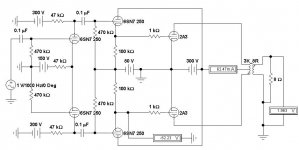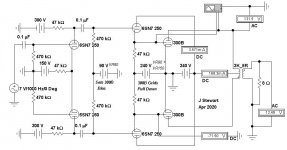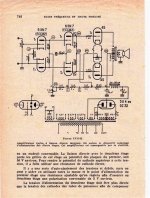A friend and i we have built two monoblock pairs OF AUDION SILVER NIGHT and they have a great sound.
One pair with simple 300B like the scheme and the other with EMISSION LABS 300BXLS, but with higher power supply 465 volts and small changes in the power supply of 6922 and 5687.
Also from the trials of the second half 6922 grid bias resistors they need to change to a little bigger.The critical resistors and capacitors are AUDIONOTE.
One pair with simple 300B like the scheme and the other with EMISSION LABS 300BXLS, but with higher power supply 465 volts and small changes in the power supply of 6922 and 5687.
Also from the trials of the second half 6922 grid bias resistors they need to change to a little bigger.The critical resistors and capacitors are AUDIONOTE.
Attachments
Going thru the various ccts it appears that many of the alternatives simply exchange one kind of reactance for another. So the RC coupling is gone to be replaced by an auto-transformer, both ccts are frequency selective.
Here is a first pass that does DC couple to the PP output tubes. It is not optimized, could be improved. Needs more gain, a 6SL7 Diff stage on the front end would cure that. The +ve & -ve PSs are not a problem, all can be got from a single CT HV wdg.
Here is a first pass that does DC couple to the PP output tubes. It is not optimized, could be improved. Needs more gain, a 6SL7 Diff stage on the front end would cure that. The +ve & -ve PSs are not a problem, all can be got from a single CT HV wdg.
Attachments
Optomized for PP 300Bs
A little more detail in this Sim. 19.5 Watts at clipping. All of the required voltages with the exception of the 300B heaters are easily produced using a common CT HV audio electronics PT. The VR tubes could be replaced by their miniature equivalents or Zener Diodes.
The Hammond 300B would be OK for this version if choke input filter was used. With Cap input the B+ is too high.
A little more detail in this Sim. 19.5 Watts at clipping. All of the required voltages with the exception of the 300B heaters are easily produced using a common CT HV audio electronics PT. The VR tubes could be replaced by their miniature equivalents or Zener Diodes.
The Hammond 300B would be OK for this version if choke input filter was used. With Cap input the B+ is too high.
Attachments
300B heaters are no problem in push-pull/fixed bias when you have a spare 5V rectifier winding or ample 6.3V winding current to spare.
That helps a lot, simplifies the power supply & can be done with an ordinary PT made for tube ccts.
Looking thru the thread again this AM it seems I completed missed the cct in post #10, it is essentially the same DC coupled arrangement as I posted. The power supply in that one could be simplified a lot, both +ve & -ve rails can be derived with a full bridge rectifier on the transformer with a CT HV connexion.
I used this kind of direct coupled cct circa 2001in something like the Circlotron setup in some Electrovoice amps. It got published in the May issue of AudioXpress magazine. The resulting amp with a pair of KT88s or 6550s easily cranked out more than 50 watts. I've put it into a PDF, if anyone wants a copy let me know.
Here is the cct where I used that direct coupled fix. The Circlotron is a bit confusing for those of us used to an ordinary PP cct. The audio output tubes form the two opposite sides of a bridge, the other two sides are the power supplies. The load (OPT) connects to the bridge at the power tube cathodes, the OPT CT is at Ground (Common). The DC current follows a path all the way around the bridge. There is no DC current in the OPT. The load impedance is 1/4 of the normal PP cct. All that greatly reduces OPT problems but the cct needs two independent HV power supplies, both off ground.
In this amp the output tubes are DC driven by a pair of 6J5 CFs. The amp front end is a two stage differential amplifier.
In this amp the output tubes are DC driven by a pair of 6J5 CFs. The amp front end is a two stage differential amplifier.
Attachments
Ref the Komuro 300B SE cct. If you pull the 6V6 driver, no problem because the 300B has voltage potential of ~295V at the grid, and ~350V at the filament (so the tube is still biased and does not become a loss, valuable or otherwise).The problem always is if the driver tube is accidentally missing/burnt - you lose the valuable 300 one too, a big turn off.
Last edited:
- Home
- Amplifiers
- Tubes / Valves
- Schematics of direct-coupled 300B Push-Pulls ?


